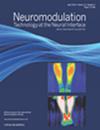Adverse Events Associated With Peripheral Nerve Stimulation: An Analysis of the MAUDE Data base and Implications for Pain and Spine Clinicians
IF 3.2
3区 医学
Q2 CLINICAL NEUROLOGY
引用次数: 0
Abstract
Summary of Background Data
The use of peripheral nerve stimulation (PNS) devices within pain and spine-related care has increased significantly in recent years. The United States Food and Drug Administration (FDA)–approved indications for PNS have expanded rapidly with technologic advances and randomized controlled trials demonstrating its efficacy. Analysis of real-world data regarding the complications associated with PNS can help inform clinical decision-making and patient counseling as the use of this neuromodulation therapy continues to evolve.
Objectives
This study aimed to categorize adverse events (AEs) described in medical device reports (MDRs) within the FDA Manufacturer and User Facility Device Experience (MAUDE) data base related to the use of PNS for pain and spinal indications.
Materials and Methods
A comprehensive search within the MAUDE data base was conducted to identify AEs related to FDA-approved PNS devices reported between January 1, 2023 and December 31, 2023, specifically to capture AEs related to current PNS technology in clinical use. AEs were manually categorized according to event descriptions.
Results
We identified 594 unique MDRs associated with the five PNS devices currently approved by the FDA for use in the spine. While most MDRs (77.1%) did not specify lead location, spinal lead placements were implicated in 9.1% of cases, and appendicular lead placement accounted for 13.8%. Infection (22.7%), migration (14.7%), and skin erosion (9.4%) were the most common AEs reported. Most entries were categorized as device-related (40.1%) or procedural AEs (32.7%), and the remainder as patient complaints (17.3%), serious AEs (1.0%), and “other” complications (6.1%). Most complications were managed with explantations (43.8%) rather than revisions (29.5%).
Discussion/Conclusion
New technologies and their applications must be regularly evaluated for safety and effectiveness. Our analysis of the MAUDE data base revealed that infection, lead migration, and skin erosion were the most commonly reported AEs associated with the use of PNS technology during 2023. Most AEs were deemed to be device- or procedure-related.
与外周神经刺激相关的不良事件:MAUDE 数据库分析及对疼痛和脊柱临床医生的启示》。
背景资料:近年来,外周神经刺激(PNS)装置在疼痛和脊柱相关护理中的应用显著增加。美国食品和药物管理局(FDA)批准的PNS适应症随着技术进步和随机对照试验证明其有效性而迅速扩大。随着这种神经调节疗法的应用不断发展,对与PNS相关的并发症的真实数据进行分析可以帮助为临床决策和患者咨询提供信息。目的:本研究旨在对FDA制造商和用户设施设备体验(MAUDE)数据库中与使用PNS治疗疼痛和脊柱指征相关的医疗器械报告(mdr)中描述的不良事件(ae)进行分类。材料和方法:在MAUDE数据库中进行了全面搜索,以确定2023年1月1日至2023年12月31日期间报告的与fda批准的PNS设备相关的ae,特别是与临床使用的当前PNS技术相关的ae。根据事件描述手动分类ae。结果:我们确定了594个与FDA目前批准用于脊柱的5种PNS设备相关的独特mdr。虽然大多数mdr(77.1%)没有明确铅的位置,但9.1%的病例涉及脊柱铅的放置,13.8%的病例涉及阑尾铅的放置。感染(22.7%)、迁移(14.7%)和皮肤糜烂(9.4%)是最常见的ae。大多数条目被归类为与器械相关(40.1%)或程序性不良事件(32.7%),其余为患者投诉(17.3%)、严重不良事件(1.0%)和“其他”并发症(6.1%)。大多数并发症的处理是解释(43.8%)而不是修复(29.5%)。讨论/结论:必须定期评估新技术及其应用的安全性和有效性。我们对MAUDE数据库的分析显示,感染、铅迁移和皮肤糜烂是2023年与PNS技术使用相关的最常见的ae。大多数ae被认为与器械或手术有关。
本文章由计算机程序翻译,如有差异,请以英文原文为准。
求助全文
约1分钟内获得全文
求助全文
来源期刊

Neuromodulation
医学-临床神经学
CiteScore
6.40
自引率
3.60%
发文量
978
审稿时长
54 days
期刊介绍:
Neuromodulation: Technology at the Neural Interface is the preeminent journal in the area of neuromodulation, providing our readership with the state of the art clinical, translational, and basic science research in the field. For clinicians, engineers, scientists and members of the biotechnology industry alike, Neuromodulation provides timely and rigorously peer-reviewed articles on the technology, science, and clinical application of devices that interface with the nervous system to treat disease and improve function.
 求助内容:
求助内容: 应助结果提醒方式:
应助结果提醒方式:


